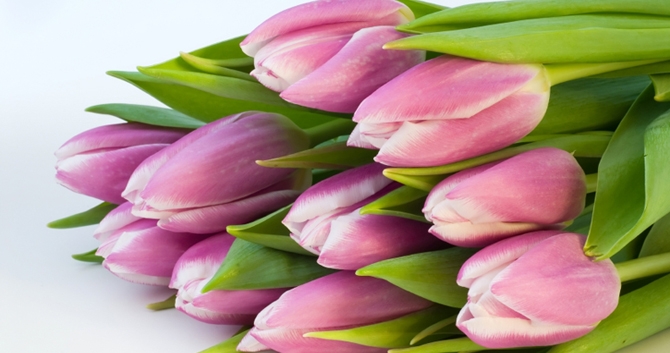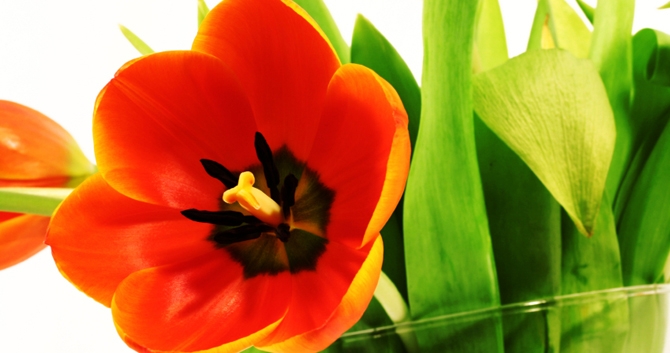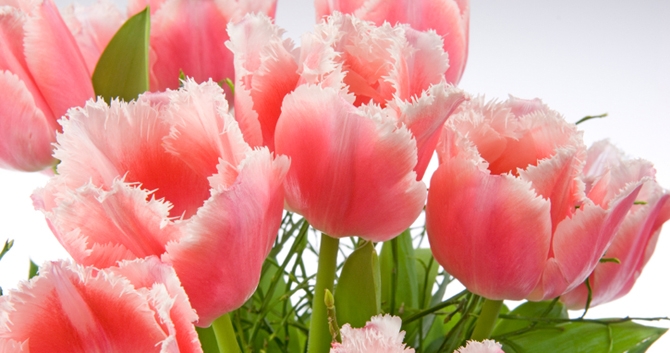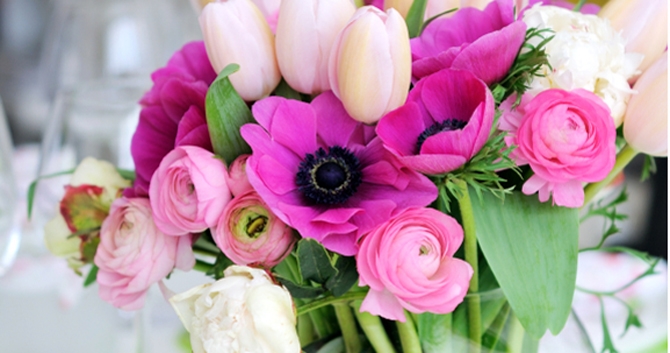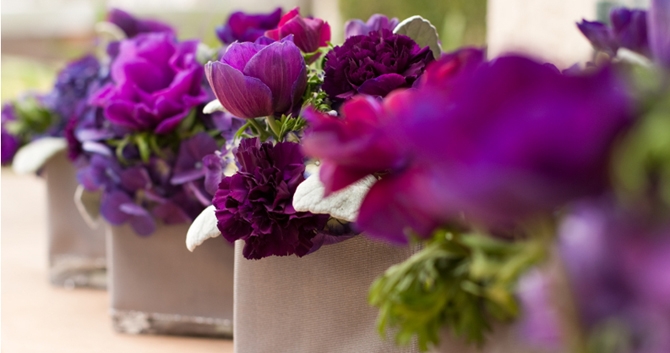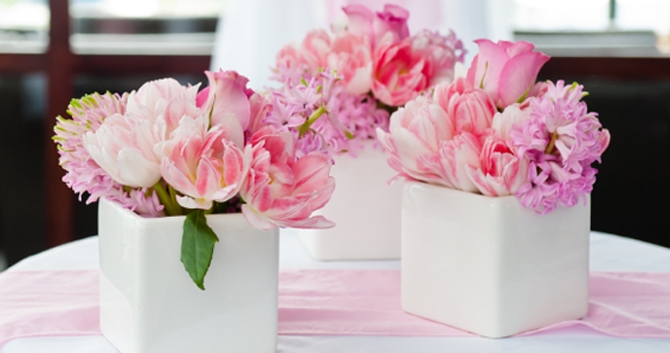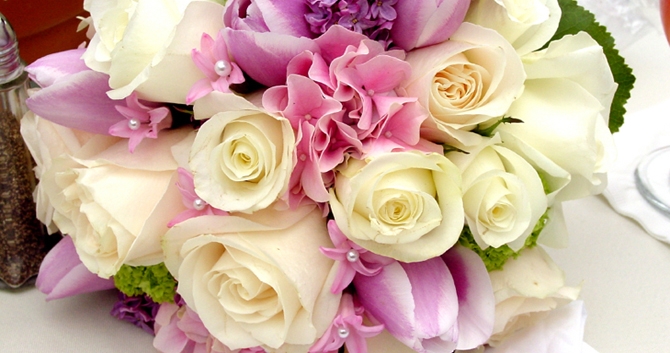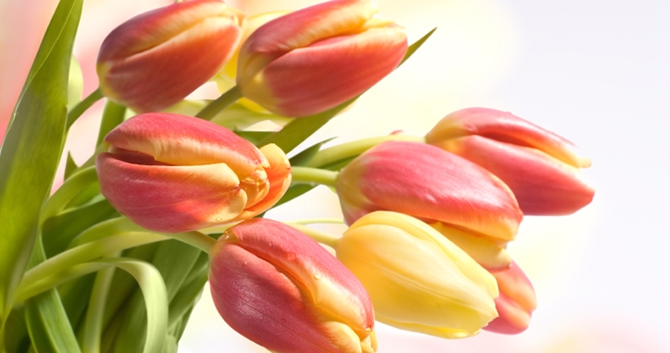Care Tips
With proper care, tulips should last from four to eight days. To maximize the vase life, look for tulips that are just starting to open. Buds should be closed, but the color of the flower should be evident. Once home follow a few simple care tips to extend the life of your blooms:
- When you get home, stand the wrapped flowers in water so they can get a good drink while you're getting the vase ready. To maximize your chances of keeping the stems straight, leave tulips in the vase with a wrap around them for a couple of hours. If you like those arching stems, feel free to start arranging right away.
- Fill a vase with water and allow it to come to room temperature. If you are using floral foam, let it soak until it is fully saturated and sinks to the bottom.
- No need to add that packet of cut flower food, as tulips don't need it.
- Slant cut the stems to the desired length. Slant cut the stems to the desired length. Flower stems naturally begin to seal their ends, so cutting them helps the flower to take in fresh clean water and extends their vase life. The shorter the stem the more water will feed the bloom.
- Remove all those large leaves that detract from the flowers and will rot if submerged.
- Arrange stems to your liking, varying the height and position. Add other flowers to the arrangement once all tulips are positioned.
- Tulips are thirsty flowers, so check the water frequently and add fresh water to fill the vase.
- Change the water if it starts looking cloudy.
About Tulips
Bring home a bouquet of tulips and you'll have an instant flower arrangement to brighten any room, a much appreciated hostess gift, or a thoughtful birthday present. You'll also have a flower with a long and devoted following since first arriving in Turkey centuries ago from the snow covered mountains of Persia.
Although Holland and tulips are inextricably linked, the Turks were the first to widely cultivate tulips, creating new and unexpected colors and shapes by creatively cross breeding wild varieties. The word tulip actually comes from the Turkish word for turban, which bears a close resemblance to the tulip's overlapping petals.
The Ottoman Empire's passion for tulips was contagious, spreading to Europe in the 1500's and eventually sparking a speculation frenzy known as tulip mania. At its peak, a single tulip bulb of a prized variety sold for as much as $4,000.
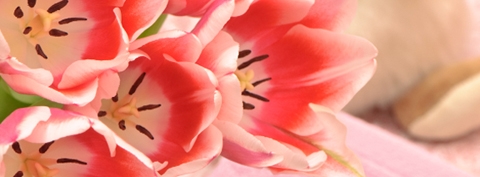 Simple and sweet, a bouquet of tulips creates an instant flower arrangement
Simple and sweet, a bouquet of tulips creates an instant flower arrangement
What tulips lack in fragrance they make up for in variety. Today, few flowers can match the color palette of tulips. Their solids, variegated, and multi-color blooms cover the spectrum from white, yellow, and green to orange, scarlet, and purple in soft pastels and vibrant saturated hues. Flower types are equally diverse, including petal, parrot, fringed, double flowering, multi-flowering, and lily flowering.
There are as many meanings associated with tulips as there are colors. Red tulips are widely considered to be the symbol of true love, based on the legend of a Turkish prince who, upon learning of the death of his beloved, galloped his horse off a cliff to end his life. A scarlet tulip was said to have sprung up from each droplet of his blood, a symbol of his perfect love.
Other colors have also come to signify sentiments of love and friendship.
Pink signifies affection and caring.
Orange expresses desire and passion.
Cream means "I will love you forever."
Yellow expresses cheerful thought.
White conveys forgiveness and purity.
With these affectionate associations, tulips are popular wedding flowers and are the official 11th wedding anniversary flower.
When designing with tulips, don't be surprised if those perfectly arranged tulips aren't in the same place you arranged them. Unlike most other flowers, tulips continue to grow after being cut, sometimes as much as an inch. As their stems reach upwards and their flowers lean towards the light, tulips begin to arch, bend and twist. Like floral designers, learn to enjoy the progression, resisting the urge to readjust the arrangement. Unless of course, like us you have to tinker, then see the Sidebar below for how to straighten those drooping stems.
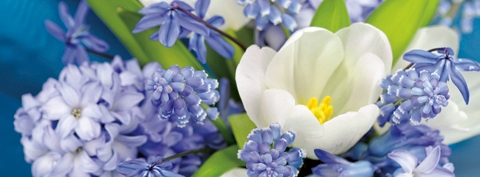 These iconic spring flowers pair perfectly with other spring bulbs like hyacinth
These iconic spring flowers pair perfectly with other spring bulbs like hyacinth
Inspiration
Vibrant and versatile, tulips are fool-proof when it comes to creating a centerpiece for a dinner party, an everyday arrangement, or bridal bouquet.
Looking for a riot of color? Try combining multi-colored parrot or fringed tulips in contrasting colors like crimson and yellow or fuchsia and chartreuse.
Want something understated? Look for French or peony tulips in pale shades of yellow, pink, salmon, and lavender.
Mix and match tulips with your favorite flowers to create a look that reflects your personal style or borrow from our ideas or tulip arrangements below:
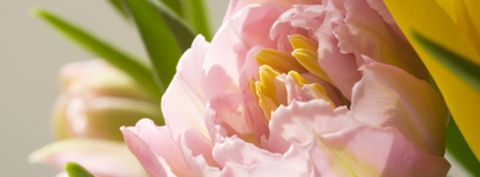 Double flowering varieties resemble peonies in coloring and shape
Double flowering varieties resemble peonies in coloring and shape
Classic:
Fill an antique vase with tulips of different heights, letting them fall in different directions. Tightly tuck-in mums to add texture and depth. Also try combining tulips with iris, hyacinth, or peonies. The variation in size and shape is stunning.
Simple:
Combine roses, mums and tulips in monochromatic or mixed colors to create interest and texture.
Modern:
Tulips look great in one color or mix them up with multiple colors. Bunch ruskus leaves or other foliage around the collar or a bunch to one side.
Spring:
These iconic spring flowers pair perfectly with early spring branches like cherry blossoms, lilacs, forsythia, pussy willows, and corkscrew willow. Although they're another classic spring flower, resist the urge to pair with daffodils in the same vase. The sap from the daffodils can kill the tulips.
Fall:
Don't overlook tulips for fall or winter decorating. Look for rich deep shades of burgundy, crimson, and deep magenta that complement the seasonal shades of scarlet, rust, and pumpkin.
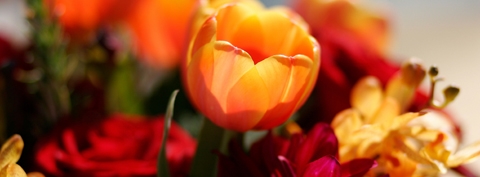 Available in autumn colors, tulips aren't just for spring arrangements
Available in autumn colors, tulips aren't just for spring arrangements
Bridal:
If you are planning a wedding there are sure to be tulips to match your color scheme and style, from relaxed to sophisticated. For a simple, elegant bridal bouquet, hand-tie a cluster of white peony or French tulips with a green collar of leaves. Try pairing tulips with calla lilies and roses for an elegant centerpiece in monochromatic shades that coordinate with your color scheme.
Unexpected:
Mix tulips with herbs like rosemary or oregano to add gentle fragrance or head to the produce aisle and look for interesting foliage like artichokes, lemons, limes, and even broccoli rabe!

